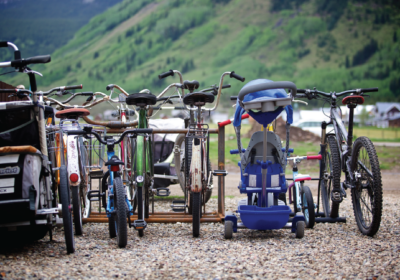
Hall of Famer: Crested Butte’s John Norton
A life well skied…
By Dawne Belloise
Longtime local and mountain enthusiast John Norton was immortalized this past summer by the Colorado Snowsports Museum and Hall of Fame as he was inducted for his lifelong career contributions to the industry in Crested Butte and Aspen.
Adding his name to the great legends including Crested Butte’s Al Johnson, Ralph Walton and Dick Eflin, as well as Aspen’s Walter Paepcke, Friedl Pfeifer and Fred and Elli Iselin, the organization recognizes Norton’s dedication to marketing programs, special events, terrain expansion, community alliance-building and the guest experience. He was inducted as a ski industry innovator in the Sports Builder category.
Crash Landing!
Norton landed in Crested Butte in July of 1985 from New York City after spending his early career in marketing with Procter and Gamble. He recalls, “Every time the company wanted to move me, I asked about Denver. I loved the mountains,” and when he figured out that relocation wasn’t going to happen through his company, he set out to find his own way to the mountains. Back then, Crested Butte Mountain Resort (CBMR) owners Edward Callaway and Ralph Walton had been looking within the ski industry for a marketing vice president but couldn’t find one. It was Callaway, whom Norton had known from Dartmouth College who suggested Norton as a candidate for the job even though he didn’t have any ski industry experience. Norton and his wife Robin decided to head west and check it out first.
They arrived in April 1985 after the lifts had closed. “I thought it was so beautiful, the whole valley. I was in awe driving up.” In fact, he was in such awe of the scenery that he drove off the road and totaled the company Subaru. They were fine but Norton laughs, “That was day one.”
Out of the Box: Ski Free?
Many remember and took advantage of CBMR’s out-of-the-box “Ski Free” promotion, and you have John Norton to thank for those days when lift tickets cost absolutely nothing. But given CB’s location most people had to come and stay for a few days so money was spent. It was an ingenious plan to bolster revenue for the late November, early December part of the ski seasons that normally was dead. He had conjured to solve an early season attendance problem.
“We would open and lose money between Thanksgiving and Christmas. There weren’t any flights and no one was here.” So Norton pitched the idea to his CBMR bosses of a delayed opening until Christmas, explaining that they’d not only save money but could then use those saved funds for ski patrol and to open the extreme terrain early. Callaway promptly nixed Norton’s idea and reminded Norton that his job was to figure out how to make money in that dead season.
But Norton thought, “To get people here, then we have to practically give skiing away, but if we’re giving it away how do we make money? Everybody was going broke,” he says of the slump season. “I went to the hotel people in the valley and asked if they’d give us $20 a night (from their bookings) if we had free skiing.” Then he solicited restaurants and retailers for 10% of their increase. At the time, he was on the CB town council, so he recused himself when he also requested 10% of the sales tax increase. Every sector, from council to businesses, unanimously agreed to contribute to the Free Ski concept. They started the campaign in 1991 and, through various iterations, it went on for nine years and was a tremendous success. “Everybody made money,” he says of the popular program.
Extreme Lifts!
It was Norton who argued for the North Face and High Lift installations. He recalls Ralph Walton growing weary of hearing him preach about both lifts, and suggested that Norton essentially put his money where his mouth was. “Ralph said to me, if you want a North Face lift so badly, buy it out of your marketing budget.” Walton figured that would be the end of it, but the wheels started spinning in Norton’s head. “I went back to my office and thought about it, and you know what, I felt it was worth doing.”
Norton had a chat with mountain operations to see how much the lift would cost. “It was about $550,000 for the original Poma that we could buy used from Ski Broadmoor, which had gone defunct.” Then he told Walton that the marketing department would buy the lift and install it. “Ralph was in shock. He was thinking that there’d be no marketing budget for a year,” but Norton convinced him that not only would it be okay, but they’d make a lot more money. The lift was installed in 1988. “And that’s why we have a North Face Lift,” he grins.
When the press caught wind of the endeavor, Norton recalls “We were absolutely assaulted by the ski media press who thought we were doing something that was incredibly irresponsible and leading to all sorts of carnage. Bob Gillen, who was running our PR, told Ski Magazine that we didn’t expect to be carrying a bunch of skiers off the hill in body bags. The patrol had a lot of fun with that quote and that’s where the name for the run Body Bag came from on the North Face. There’s another run named Dead Bob’s. Both came from Bob’s PR efforts.”
A move over the hill…and back again
Norton continually pressed for terrain expansions and lift upgrades, but the ownership of CBMR didn’t want to spend the money to do any of it. “Aspen was doing great at that time, and still is, and I wanted to go work for someone who wanted to win,” he says. He and Robin left Crested Butte for Aspen in 1991. “It was a terrific move. I was certainly heartbroken to leave this community, but Aspen is a terrific community as well. We had major expansions on all four mountains and were installing one or two lifts a year while I was there.”
In 2002, as Norton was entertaining the idea of change to a different ski complex, Edward Callaway asked him to return to CB because “This is where your heart is and the company is all yours,” Norton recalls the conversation. “We were driving over Kebler and had not made up our minds yet but when we came around the curve where you can see Crested Butte Mountain, my wife said, ‘We can’t go anywhere else. Let’s go home to CB.” Norton returned as CEO of CBMR in 2002.
CB is still home
Norton hadn’t realized the financial difficulties the company had encountered in his years away. “It was pretty clear to me and Edward that I needed to turn the company way around in terms of revenues in two years or sell the company.” They ended up selling the company to the Mueller family in 2004. Norton stayed through the fall of that year and continued as a consultant for seven years.
These days, Norton runs the area’s Tourism and Prosperity Partnership (TAPP) in the Gunnison Valley as its executive director. “I was asked to step in on a temporary basis in 2016, and then the new board asked me to stay on,” he says. “We do sustainable tourism, and all the trailhead kiosks around the valley. We also do economic development and we help to grow entrepreneurs in the valley.” The ICELab at Western Colorado University is part of TAPP.
Norton has had a ski pass every year since 1985 and clocked in 80 days on the slopes last season. It’s not surprising that Norton feels quite honored to join the likes of the 10th Mountain Division and so many great athletes and ski area founders in the Colorado Snowsports Hall of Fame. “It’s something really special and a humbling experience,” he says. “I really, really loved being in the ski business and this is icing on the cake.”
I’ve known John Norton since the 1980s. When he was inducted into the Colorado Snowsports Hall of Fame this past summer it brought back memories of those times in the late ‘80s and early ‘90s when John was tasked with marketing a small CBMR ski area without a lot of capital. He rose to the challenge and helped to put Crested Butte on the ski world map despite its inability to make a splash in the normal ways ski areas received attention: moves like major terrain expansions, new lifts or new base areas. No, John focused on the foundation of the sport — fun — and people noticed.
Given space constraints and the fact we are talking about a ski marketer, I’m combining some of the highlights of his initiatives into three stories. As any marketer might say, “why let facts get in the way of a good story?” But the story is actually based in fact…
The first is the time he had the National Association of Ski Journalists coming to Crested Butte—but had nothing to show them. At the formal correspondents’ dinner on Saturday night, Norton had it set up to get the national ski press excited about a big announcement. Was it a ski expansion? The first 10-person lift?
After plying the writers with happy hour drinks, dinner wine and après dinner cocktails, the lights in the room dimmed and the music got louder. All eyes were on the stage and out comes Norton in just a bathing suit with the words “Do Not Try This at Home” sharpied on his chest and a pair of Hotfinger ski gloves dipped in gasoline that were on fire. What the?! He had the attention of the press and he built up the fact that CBMR was the first ski resort in the industry to acquire the latest Hobart Cheese Slicer for the Paradise Warming House. He emphasized that the company cheese slicing ability would increase by 40% and that’s what real skiers cared about. CBMR’s ability to increase cheese availability to the masses would bring in the skiing hoards. Not only did he get good laughs, but CBMR got tons of good press from writers who understood the fun he was having and recommended people check out a funky place – The Last Great Colorado Ski Town.
The second example is that one season he told upper management he needed to have something interesting to market but they said there was no money for major upgrades. So, he took dollars out of his lean marketing budget to pay for a used surface lift to access the extreme North Face terrain on Crested Butte Mountain. The move was not uncontroversial with the community at the time, but the old Poma provided “lift access” to hundreds of new acres of skiing that were considered “extreme.” Again, the ski industry press embraced the story and CBMR became a leader in the Extreme Terrain ski world. It remains that way today.
The third story would be the Ski Free promotion, another interesting and not uncontroversial move. He said at the time that the word “Free” was one of the most powerful words in the English language—and it must have been as thousands of people poured into town for the first Ski Free. It was wild. Luck came into play as for one of the only times in history the resort was able to have 100% of the terrain—including the Extremes—open from Day 1 on Thanksgiving Weekend. He related that others in the industry watched in amazement and one fellow ski notable summarized that “people will pay a lot of money to get something for free.” The idea worked as Crested Butte was too far for most people to come on a day trip so lodges and restaurants in town all made more money than they ever had that early in the ski season and CBMR got a small cut. Associated with initial Ski Free was his idea to hire a plane and drop tens of thousands of free lift tickets over Mile High Stadium during a Monday night Denver Broncos game. That idea was shelved by the CBMR owners when the company lawyers predicted that not only would Norton go to jail for such a stunt but the owners would as well. Turns out that stunt wasn’t needed to get thousands of new skiers to Crested Butte.
The bottom line is that while it was fishing that initially drew Norton to the mountains, he quickly embraced all these mountains had to offer. And he understood that mountains provided opportunity for fun. It was his career goal to share that with as many people as possible and by that metric, he has had a phenomenally successful—and fun—career. Congrats to John for being a member of the Hall of Fame.
—Mark Reaman







